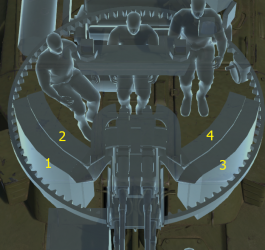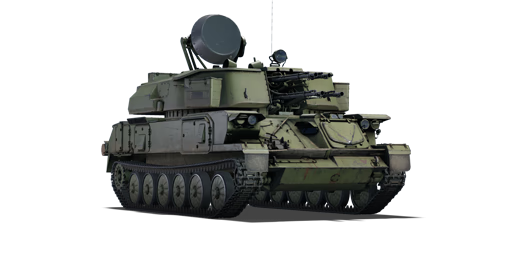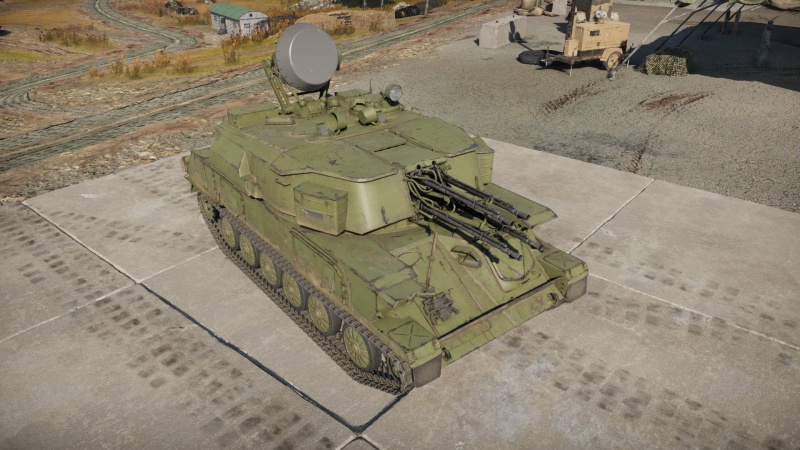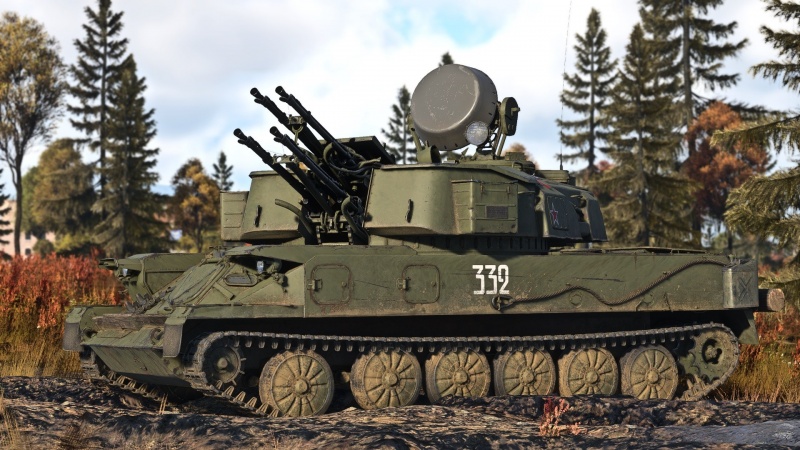Difference between revisions of "ZSU-23-4"
(→Description) (Tag: Visual edit) |
m (→See also) (Tag: Visual edit) |
||
| (8 intermediate revisions by 7 users not shown) | |||
| Line 1: | Line 1: | ||
{{About | {{About | ||
| about = Soviet SPAA '''{{PAGENAME}}''' | | about = Soviet SPAA '''{{PAGENAME}}''' | ||
| − | | usage = the other | + | | usage = the other versions |
| − | | link = ZSU-23-4 ( | + | | link = ZSU-23-4 (Family) |
}} | }} | ||
{{Specs-Card | {{Specs-Card | ||
| Line 11: | Line 11: | ||
== Description == | == Description == | ||
<!-- ''In the description, the first part should be about the history of the creation and combat usage of the vehicle, as well as its key features. In the second part, tell the reader about the ground vehicle in the game. Insert a screenshot of the vehicle, so that if the novice player does not remember the vehicle by name, he will immediately understand what kind of vehicle the article is talking about.'' --> | <!-- ''In the description, the first part should be about the history of the creation and combat usage of the vehicle, as well as its key features. In the second part, tell the reader about the ground vehicle in the game. Insert a screenshot of the vehicle, so that if the novice player does not remember the vehicle by name, he will immediately understand what kind of vehicle the article is talking about.'' --> | ||
| − | |||
| − | + | Arguably the single most iconic self-propelled anti-aircraft gun of the Soviet Union during the Cold War, the '''ZSU-23-4 ''Shilka''''' is a force to be reckoned with. First fielded in 1965, the Shilka completely superseded its predecessor, the antiquated [[ZSU-57-2]] by the 1970s. Notable upgrades were a radar fire control system to assist gunners in aiming the gun, a gun stabilizer to enable firing on the move, as well as the search radar itself which greatly assisted in awareness. Designed on the [[ASU-85]] hull, the Shilka was almost fielded alongside its competitor, the [[ZSU-37-2]] Yenisei, but the Yenisei was cancelled during a hearing and the Shilka became the backbone of the Soviet air defense suite. The Shilka served a long and illustrious career with the Soviet Armed Forces and many other militaries around the world, seeing combat across the globe. One notable use was in the Soviet-Afghan War, where Shilkas had their radars removed and additional ammunition was added and were used against enemy guerilla fighters to devastating effect. | |
| + | |||
| + | Introduced in [[Update 1.63 "Desert Hunters"]], the "Shilka" presents a much higher rate of fire than its predecessor [[ZSU-57-2]], and allows the user to oversaturate a given area of the sky to increase the odds of hitting an enemy aircraft. The Shilka is unlocked after the [[ZSU-37-2]] Yenisei, its unproduced rival, and usage cases between the two differ. The Yenisei deals a heavier, crippling blow with its 37 mm cannon, but lacks the volume of fire of the Shilka to saturate an area, while the Shilka lacks comparative engagement range as well as the penetration to go through enemy armour from the side consistently. The Shilka is best used at sub-2 km ranges, when enemies have little room to manoeuvre from the sheer amount of shells being thrown in the air, and is second to none in this role. | ||
== General info == | == General info == | ||
| Line 130: | Line 131: | ||
You have a high ammo count with this vehicle, meaning that you can afford to find a good spot away from the main fight in order to pick off enemy planes. Unless you need to reload your ammo, avoid spawn points. They are usually the hub of most of the fighting and going to them will put you in the firing line. | You have a high ammo count with this vehicle, meaning that you can afford to find a good spot away from the main fight in order to pick off enemy planes. Unless you need to reload your ammo, avoid spawn points. They are usually the hub of most of the fighting and going to them will put you in the firing line. | ||
| − | While it is fully enclosed, the ZSU-23-4 has armour which makes the M18 Hellcat look like a heavy tank. Even 7.62mm machine guns stand a fair chance of penetrating this vehicle. This makes you a primary target for aircraft, which at this vehicles BR are usually armed with cannons or high penetration machine guns, which will easily take you out. | + | While it is fully enclosed, the ZSU-23-4 has armour which makes the M18 Hellcat look like a heavy tank. Even 7.62mm machine guns stand a fair chance of penetrating this vehicle, although the slightly increased angle provides marginally better protection over the Yenisei. This makes you a primary target for aircraft, which at this vehicles BR are usually armed with cannons or high penetration machine guns, which will easily take you out. |
Top rank helicopters and the FJ-4B VMF 232 are the greatest threat to your existence. They are both capable of sitting comfortably outside your firing range while firing lethal ATGMs at you. Hide from them until they are either dealt with by an allied plane or they come close enough to be dealt with by your 23 mm cannons. | Top rank helicopters and the FJ-4B VMF 232 are the greatest threat to your existence. They are both capable of sitting comfortably outside your firing range while firing lethal ATGMs at you. Hide from them until they are either dealt with by an allied plane or they come close enough to be dealt with by your 23 mm cannons. | ||
| Line 178: | Line 179: | ||
* ''links to approximate analogues of other nations and research trees.'' --> | * ''links to approximate analogues of other nations and research trees.'' --> | ||
| − | ''' | + | '''Related development''' |
| + | |||
| + | * [[ZSU-23-4 (Family)]] | ||
| + | ** [[ZSU-23-4M4]] | ||
| + | |||
| + | '''Vehicles with similar weapon systems''' | ||
* [[BTR-ZD]] | * [[BTR-ZD]] | ||
| − | ''' | + | '''Vehicles of similar configuration or role''' |
| − | * [[ | + | * [[ZSU-37-2]] |
* [[SIDAM 25]] | * [[SIDAM 25]] | ||
* [[AMX-30 DCA]] | * [[AMX-30 DCA]] | ||
| + | * [[M163]] | ||
== External links == | == External links == | ||
Revision as of 01:13, 9 August 2024
| This page is about the Soviet SPAA ZSU-23-4. For the other versions, see ZSU-23-4 (Family). |
Contents
Description
Arguably the single most iconic self-propelled anti-aircraft gun of the Soviet Union during the Cold War, the ZSU-23-4 Shilka is a force to be reckoned with. First fielded in 1965, the Shilka completely superseded its predecessor, the antiquated ZSU-57-2 by the 1970s. Notable upgrades were a radar fire control system to assist gunners in aiming the gun, a gun stabilizer to enable firing on the move, as well as the search radar itself which greatly assisted in awareness. Designed on the ASU-85 hull, the Shilka was almost fielded alongside its competitor, the ZSU-37-2 Yenisei, but the Yenisei was cancelled during a hearing and the Shilka became the backbone of the Soviet air defense suite. The Shilka served a long and illustrious career with the Soviet Armed Forces and many other militaries around the world, seeing combat across the globe. One notable use was in the Soviet-Afghan War, where Shilkas had their radars removed and additional ammunition was added and were used against enemy guerilla fighters to devastating effect.
Introduced in Update 1.63 "Desert Hunters", the "Shilka" presents a much higher rate of fire than its predecessor ZSU-57-2, and allows the user to oversaturate a given area of the sky to increase the odds of hitting an enemy aircraft. The Shilka is unlocked after the ZSU-37-2 Yenisei, its unproduced rival, and usage cases between the two differ. The Yenisei deals a heavier, crippling blow with its 37 mm cannon, but lacks the volume of fire of the Shilka to saturate an area, while the Shilka lacks comparative engagement range as well as the penetration to go through enemy armour from the side consistently. The Shilka is best used at sub-2 km ranges, when enemies have little room to manoeuvre from the sheer amount of shells being thrown in the air, and is second to none in this role.
General info
Survivability and armour
Armour type:
- Rolled homogeneous armour
| Armour | Front | Sides | Rear | Roof |
|---|---|---|---|---|
| Hull | 9.4 mm (57°) | 9.4 mm | 9.4 mm (46°) Upper 9.4 mm (22°) Lower |
9.4 mm |
| Turret | 8.9 mm (23°) | 8.9 mm (8-10°) | 8.9 mm (1°) | 8.9 mm |
| Cupola | 8.9 mm | 8.9 mm | 8.9 mm | 8.9 mm |
Notes:
- Suspension wheels are 20 mm thick while tracks are 15 mm thick.
- Belly armour is 9.4 mm thick.
Mobility
| Game Mode | Max Speed (km/h) | Weight (tons) | Engine power (horsepower) | Power-to-weight ratio (hp/ton) | |||
|---|---|---|---|---|---|---|---|
| Forward | Reverse | Stock | Upgraded | Stock | Upgraded | ||
| Arcade | 55 | 8 | 20.7 | 398 | 534 | 19.23 | 25.8 |
| Realistic | 51 | 7 | 248 | 280 | 11.98 | 13.53 | |
Modifications and economy
Armaments
Main armament
| 23 mm AZP-23 (x4) | Turret rotation speed (°/s) | Reloading rate (seconds) | ||||||||||||
|---|---|---|---|---|---|---|---|---|---|---|---|---|---|---|
| Mode | Capacity (Belt) | Fire rate | Vertical | Horizontal | Stabilizer | Stock | Upgraded | Full | Expert | Aced | Stock | Full | Expert | Aced |
| Arcade | 2,000 (500) | 850 | -4°/+85° | ±180° | Two-plane | 61.6 | 85.3 | 103.6 | 114.6 | 121.9 | 5.20 | 4.60 | 4.24 | 4.00 |
| Realistic | 41.6 | 49.0 | 59.5 | 65.8 | 70.0 | |||||||||
Ammunition
- Default: API-T · HEF-I
- HEFI-T: HEF-I · HEFI-T · HEF-I · API-T
- APIT: API-T · API-T · API-T · HEFI-T
| Penetration statistics | |||||||
|---|---|---|---|---|---|---|---|
| Ammunition | Penetration @ 0° Angle of Attack (mm) | ||||||
| 10 m | 100 m | 500 m | 1,000 m | 1,500 m | 2,000 m | ||
| HEF-I | 6 | 6 | 4 | 3 | 2 | 2 | |
| API-T | 51 | 48 | 36 | 26 | 18 | 13 | |
| HEFI-T | 6 | 6 | 4 | 3 | 2 | 2 | |
| Shell details | ||||||||||||
|---|---|---|---|---|---|---|---|---|---|---|---|---|
| Ammunition | Velocity (m/s) |
Projectile mass (kg) |
Fuse delay (m) |
Fuse sensitivity (mm) |
Explosive mass (TNT equivalent) (g) |
Ricochet | ||||||
| 0% | 50% | 100% | ||||||||||
| HEF-I | 980 | 0.18 | 0.1 | 0.1 | 28.49 | 79° | 80° | 81° | ||||
| API-T | 970 | 0.19 | - | - | - | 47° | 60° | 65° | ||||
| HEFI-T | 970 | 0.19 | 0.1 | 0.1 | 20.02 | 79° | 80° | 81° | ||||
Ammo racks

| Full ammo |
1st rack empty |
2nd rack empty |
3rd rack empty |
4th rack empty |
Visual discrepancy |
|---|---|---|---|---|---|
| 4 | 0 (+4) | 0 (+4) | 0 (+4) | 0 (+4) | No |
Radars
The ZSU-23-4 is equipped with a 1RL33 search and tracking radar, mounted on top of the turret, at the rear. The radar system lacks track while scan, but can track targets in a full 360° area around the turret (instead of just to the front of the turret). The radar has very slow scan speed.
| By default the radar will scan a 60° arc, this can be changed to a 360° scan if desired, using the "change radar search mode" key. |
| 1RL33 - Target Detection Radar | ||||
|---|---|---|---|---|
| Maximum Detection Range |
Minimum Detection Range |
Max Azimuth Scan Angle |
Max Elevation Scan Angle |
Minimum relative speed |
| 20,000 m | 100 m | ±30° (optionally 360°) | -9°/+87° | 15 m/s (54 km/h) |
| 1RL33 - Target Tracking Radar | ||||
| Maximum Tracking Range |
Minimum Tracking Range |
Azimuth Tracking Angle |
Elevation Tracking Angle |
Minimum relative speed |
| 16,000 m | 100 m | 360° | -9°/+87° | 15 m/s (54 km/h) |
Usage in battles
The ZSU-23-4 should be played entirely as an AA vehicle. Do not go tank hunting in this vehicle, as you do not have the armour or the penetration. Focus on keeping the skies clear, something that this vehicle does very well. A high rate of fire and very fast turret traverse means that you should be able to target and destroy even the fastest jets.
You have a high ammo count with this vehicle, meaning that you can afford to find a good spot away from the main fight in order to pick off enemy planes. Unless you need to reload your ammo, avoid spawn points. They are usually the hub of most of the fighting and going to them will put you in the firing line.
While it is fully enclosed, the ZSU-23-4 has armour which makes the M18 Hellcat look like a heavy tank. Even 7.62mm machine guns stand a fair chance of penetrating this vehicle, although the slightly increased angle provides marginally better protection over the Yenisei. This makes you a primary target for aircraft, which at this vehicles BR are usually armed with cannons or high penetration machine guns, which will easily take you out.
Top rank helicopters and the FJ-4B VMF 232 are the greatest threat to your existence. They are both capable of sitting comfortably outside your firing range while firing lethal ATGMs at you. Hide from them until they are either dealt with by an allied plane or they come close enough to be dealt with by your 23 mm cannons.
Pros and cons
Pros:
- High rate of fire; allows for area saturation
- Relatively high top speed
- High ammo count
- Fast turret traverse
- Can penetrate lightly armoured vehicles (other SPAAs)
- Radar-assisted fire control; a lead indicator is shown in Realistic.
Cons:
- Thin armour; aircraft cannons will cause severe damage
- Low power to weight ratio; struggles with slopes and off-road
- Low penetration for 23 mm cannons; means troubles penetrating certain MBTs from the side
- Radar has very low scan speed
History
Development
The main Soviet self-propelled anti-aircraft vehicle ZSU-57-2, in service since 1955, did not perform satisfactory due to the lack of radar tracking, low rate of fire, and small ammo count for its high-power autocannons. Its firepower was supplemented by the ZPU and ZU series of anti-aircraft mounts using the 14.5 mm and 23 mm armaments respectively. The ZPU and ZU were towed or truck-mounted and had a high rate of fire, but suffered from low mobility when not on a truck and lack of protection if mounted on a truck for a mobile role. It became desirable to combine the traits of these two type of anti-aircraft weaponry together for a tracked anti-aircraft vehicle to be protected, have good mobility, contain a good amount of ammo, and deliver a high rate of fire with heavy-hitting calibre.
Development started in 1957 for this vehicle, ready to be evaluated in 1962. The vehicle went under the name ZSU-23-4 "Shilka", named after the Shilka River in South-Eastern Russia. The first set of digits signifies the calibre, 23 mm, and the second signifies the number of cannons, 4. Equipped with four water-cooled 23 mm autocannons, the ZSU-23-4 is aimed via manual optics or with a radar that can track aircraft up to 6 km away and guide the armaments to a estimated coordinate. The vehicle can carry up to 2,000 rounds of 23 mm ammunition and each cannon has a fire rate of between 850-1,000 rpm. The ZSU-23-4 was built on a GM-575 chassis, which itself is based off the PT-76. It was accepted for service by the Soviet Army in 1965 and proceeded to replace all the ZSU-57-2 still in stock by the 1970s. From the time period 1964 to 1982, up to 6,500 ZSU-23-4 were produced at the Mytishchi Engineering Works.
Combat usage
The Soviet Army used the ZSU-23-4 as their main anti-aircraft defense weapon. It was intended that the ZSU-23-4 only guard military bases and mechanized formations while the ZSU-37-2, a side development during the Shilka's development period, guard the low-altitude area unable to be hit by surface-to-air missiles. However, the ZSU-23-4 Shilka eventually replaced it to keep a logistics simple. From Soviet doctrine, the Shilkas were organized in anti-aircraft artillery batteries with two platoons of four vehicles each. Initially, one platoon was filled with ZSU-57-2's and the other with Shilkas, but the ZSU-57's were replaced in service by the Shilkas in the 1970s. In the 1970s, the batteries were also reorganized to one platoon of Shilkas and one platoon of anti-air missile systems, both meant to supplement the dead zone from the divisional surface-to-air missile systems. The Shilkas, being very lightly armoured, mainly stay behind the main forces and the front line, ranging between 400 to 1,000 m away from the fighting. Though each Shilka unit fought with their own radar system initially, the implementation of the PPRU-1 allowed for coordinated targeting between the Shilka and missile units against enemy aircraft. Despite their intended role as an anti-aircraft, the high rate of fire, heavy calibre, and ability to elevate the guns at a high angle made it a very popular ground support weapon. This utility made it a very useful weapon in the Soviet occupation of Afghanistan, being able to fight the Mujaheddin ambushing from mountainous terrain. The Soviets also used it during the War against Chechnya, fighting the Chechens in the mountains. The ZSU-23-4 still sees use in the Russian Naval Infantry.
The ZSU-23-4 saw more usage in the hands of the Soviet Union's allies. 2,500 of the Shilkas produced were given out to up to 23 nations. It's most infamous records would come from the hands of the Arabs in the Yom Kippur War in 1973. Using the SA-6 surface-to-air missiles, they forced the Israeli planes to fly low to avoid missile detection and then blasted them away with the Shilkas. The Shilkas also saw use in the later part of the Vietnam War, where they are used nearly the same way by attacking aircraft forced low by missiles. Past that, the ZSU-23-4 saw usage in multiple conflicts in the Third World countries and are still in use today in the Syrian Civil War.
Media
- Skins
See also
Related development
Vehicles with similar weapon systems
Vehicles of similar configuration or role
External links
| USSR anti-aircraft vehicles | |
|---|---|
| GAZ-AAA | GAZ-AAA (4M) · GAZ-AAA (DShK) |
| BTR-152 | BTR-152A · BTR-152D |
| Wheeled/Half-tracked | GAZ-MM (72-K) · ZiS-12 (94-KM) · ZiS-43 |
| Radar SPAAG | ZSU-23-4 · ZSU-37-2 |
| SAM | ZSU-23-4M4 · Strela-10M2 · 2S6 · Pantsir-S1 |
| Other | ZSU-23-4M2 · ZUT-37 · ZSU-37 · BTR-ZD · ZSU-57-2 |
| Czechoslovakia | M53/59 |
| North Vietnam | ▂Phòng không T-34 |






